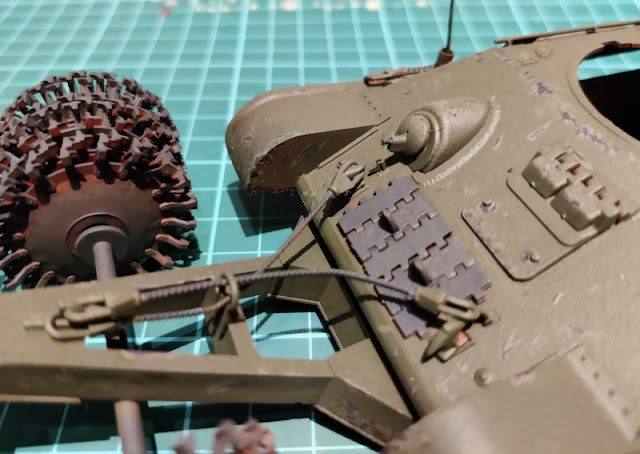Warm browns
At some point last summer I bought a paintset specifically for wood. It just caught my attention when I was buying something in Hobby Point anyway, and my preexisting wooden paints were all quite dark and getting them out of their bottles was getting dubious at this date.
I've been using Vallejo paints for ages now, and this new box was a deviation, it was by AK Interactive (a third generation paintset, ooh, aah!). Six paints, and the back of the box showed what kind of wonders a skilled painter could do witht hem. I, on the other hand, knew I wasn't a gifted artist and had no delusions of grandeour no matter what kind of a fancy-ass paintset I utilized.
Of course the bottles had colour codes that weren't the same ones in the box's examples (but they did have the corresponding codes on the side), so one had to pay attention to what they did ':)
The wooden objects
I thought that the different wooden things would be of different woods, or differently treated, so I was going to paint them in two different ways. The boxes would have a darker and the handles for the shovels and the saw were going to be lighter shade of wood.
Base colours
All the lighter bits I painted with cork (AK11119 Cork), it looked like a nice shade and I would've believed that it was birch, if someone told me so. Now I needed to have an idea of how to make them look more woodlike with textures.
Both of the boxes I painted dark brown (AK11110 Weathered wood (Leather Brown)). The planks had some surface texture on them, that I could highlight later a bit with a wash.
Here was the left side's setup as well.
Woodgraininess
In my attempt to make the wood boxes look more wooden I painted on them some more or less squiggly lines with a lighter tone (AK11117 Varnished wood (Cork)). I made sure to add some stronger curves here and there for the branches (whatever the knots were called in actualy English). This first version may have ended up a bit too careful, because the planks just had some varying length thin lines and that didn't look too realistic to me.
To fix that I went a bit against my cautious nature and made stronger lines so that the base colour would have a smaller role in the look of the boxes. These shapes looked generally acceptable, but maybe a hint too cartoony. For some highlights I was thinking of paining a few fine lines with an even lighter paint (AK11115 Freshly cut timber (Light earth)).
To get any kind of a woodgrain effect on the pretty light-coloured shovel handles I used the light brown (AK11115) that I then used to highlight the boxes. On first impression the lighter woods looked better than the darker ones. But how could one know without trying out?
Again the closeups revealed things. The saw's holder's dark chips were crappily done and there was some painted over cat hair as extra decoration. I was actually a bit surprised that our cats hadn't been more visible on these sets.
Metal bits
Because I was pleased with the effect of the somewhat suffered unpainted steel, which at best looked like electrozinced steel but at worst just frosted over, I did it again. I thinned down a light grey paint (VGA 72749 Stonewall Grey) with tap water quite a lot, then stippled it on the dark grey bits. Again this managed to reveal some untreated ejector marks or carelessly cleaned up mould lines. Graah!
Of course all of these would get later on covered with oil washes, either sepia or different rusts. Well, I had two rust shades, so it was either old or fresh rust and I usually used them both over each other.
Nails to the tool coffins
To crown my fantastic achievements I pulled a few nail places from my hat and painted (or tried to paint) tiny dots with dark grey to mark the nail ends. Of course looking at these photos I realized that the top bits were most likely nailed on each of the planks and not just the outermost ones, so it was possible that I returned to this one later on. Or maybe I'd let them be as they were, the idea of nails was already visible and that was important.



















































